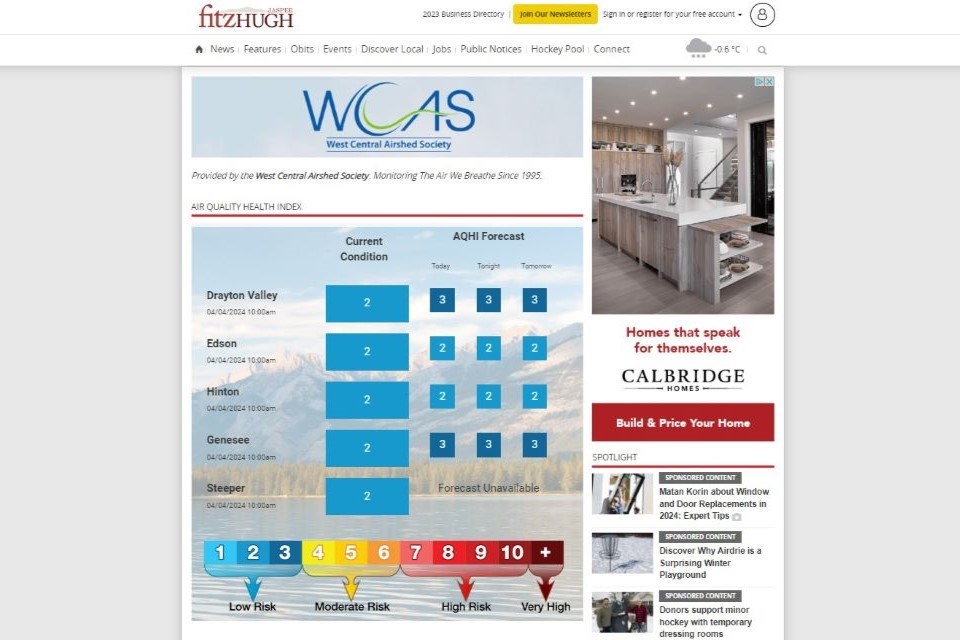Monitoring the air that you breathe just got easier now that the West Central Airshed Society (WCAS) has its Air Quality Health Index (AQHI) widget on the Fitzhugh's website.
The widget can can be found at "Air Quality Health Index" under the Features tab.
“With this new feature on our website, readers will be able to check the air quality for multiple communities across west-central Alberta,” said Peter Shokeir, editor and publisher of the Jasper Fitzhugh.
“The Fitzhugh would like to thank the West Central Airshed Society for making this possible. This feature will be of great value during the summer when the risk of wildfire will be high, particularly during this drought year.”
The widget offers frequently updated current conditions plus AQHI forecasts for Drayton Valley, Edson, Hinton, Genesee and Steeper, located near Cadomin. It includes a handy legend that helps readers to compare those conditions to the risk factor of contaminants in the air on a 1 to 10+ scale.
The AQHI is calculated by monitoring three air pollutants: ground level ozone, fine particle matter 2.5 (AKA PM2.5) and nitrogen dioxide. Airsheds are responsible for monitoring on behalf of the Alberta government.
Bringing the information about the air people breathe is a key part of the strategic plan for the WCAS: the part that involves communications and engagement, said Yvonne Barker, WCAS’s community engagement co-ordinator.
“To be able to identify and collaborate with organizations such as the Fitzhugh, it's a win-win-win. It's a win for us, it's a win for [the newspaper] as getting that information out to Jasper and the local area. As well it’s a win for the residents and the tourists coming in to be able to have that awareness and be able to make informed decisions about their health,” she said.
“This is big for us, too.”
This is the first time that the Airshed Society has partnered with a newspaper on such an initiative, although it does regularly offer a similar feature with the municipalities that have their own air monitoring station.
Jasper doesn’t have any info included on the widget because the municipality currently doesn’t have its own monitoring station. The society is working with its partners throughout different orders of government to change that in the future.
“Jasper has been identified as a community that needs the Air Quality Health Index air monitoring. Jasper is nestled in the mountains. It's closest AQHI monitoring is 100 kilometres east in Hinton, which is where it's getting this reading. We're really working on getting this AQHI monitoring into the Jasper area,” Barker said.
“We know that there's a need for it there. It’s the first area that is coming in from B.C., and with the mountain it kind of traps things in there. We really want to know what that air is like there and how can we bring that awareness to whoever is using and sharing the park.”
There are, however, three PurpleAir monitoring sites here in town. Data from those sites can be found on the Live Air Data Map on the WCAS’s website. Those sensors focus on PM2.5, which refers to particulate matter that has a diameter of 2.5 micrometres or smaller. This is most prevalent during wildfire season as well as from vehicle emissions, a problem that also heightens during the busy tourist summer season.
An airshed is a geographical area where the air is subject to similar environmental conditions throughout it. There are 10 Airshed Societies throughout the province, which represents more than 90 communities. These societies get funding through industry.
The WCAS itself is an impartial non-profit organization that represents communities from the British Columbia border to the Wabamun Lake area.
Air quality information can be vital for people with compromised immune systems or pulmonary or cardiovascular problems such as the very young and the very old.





